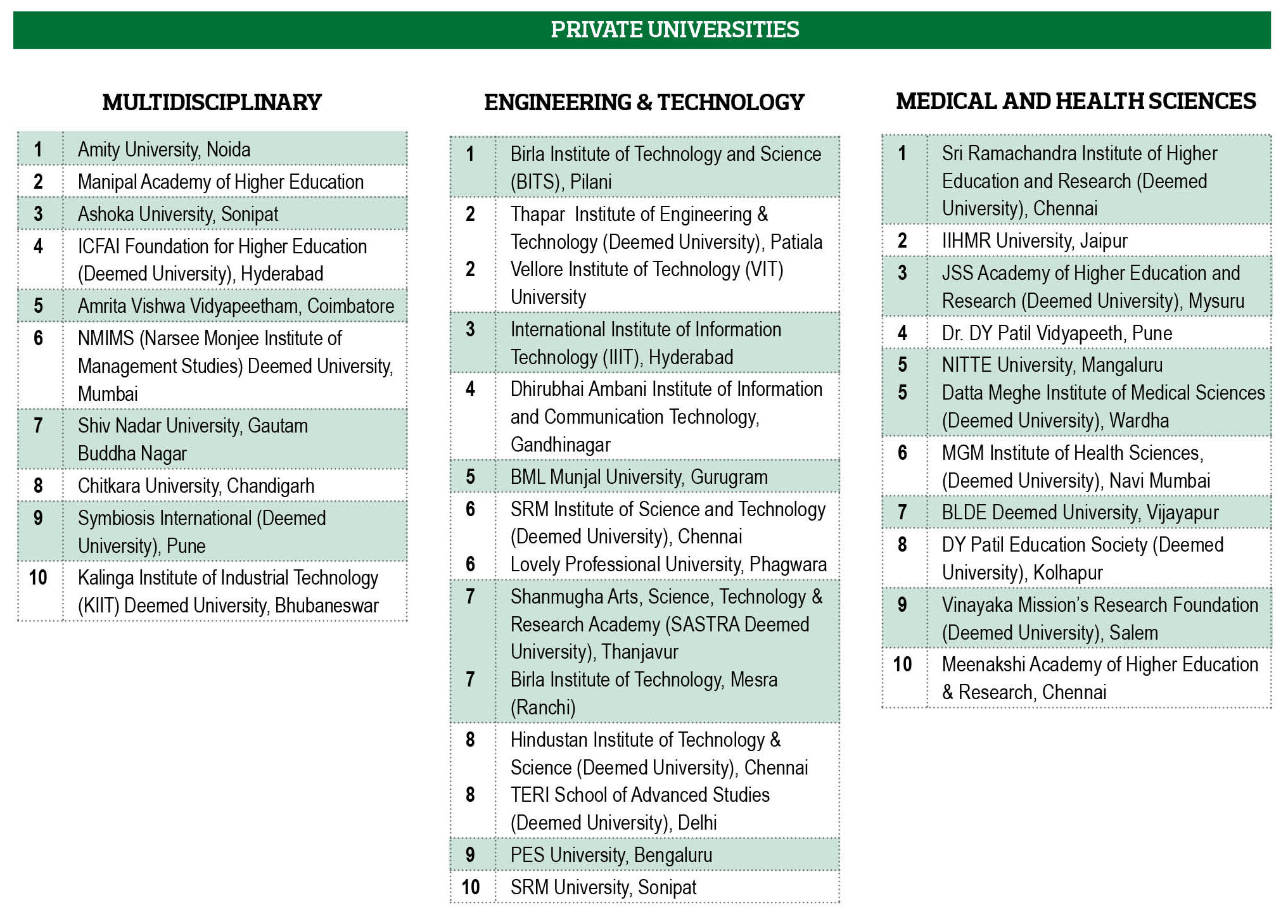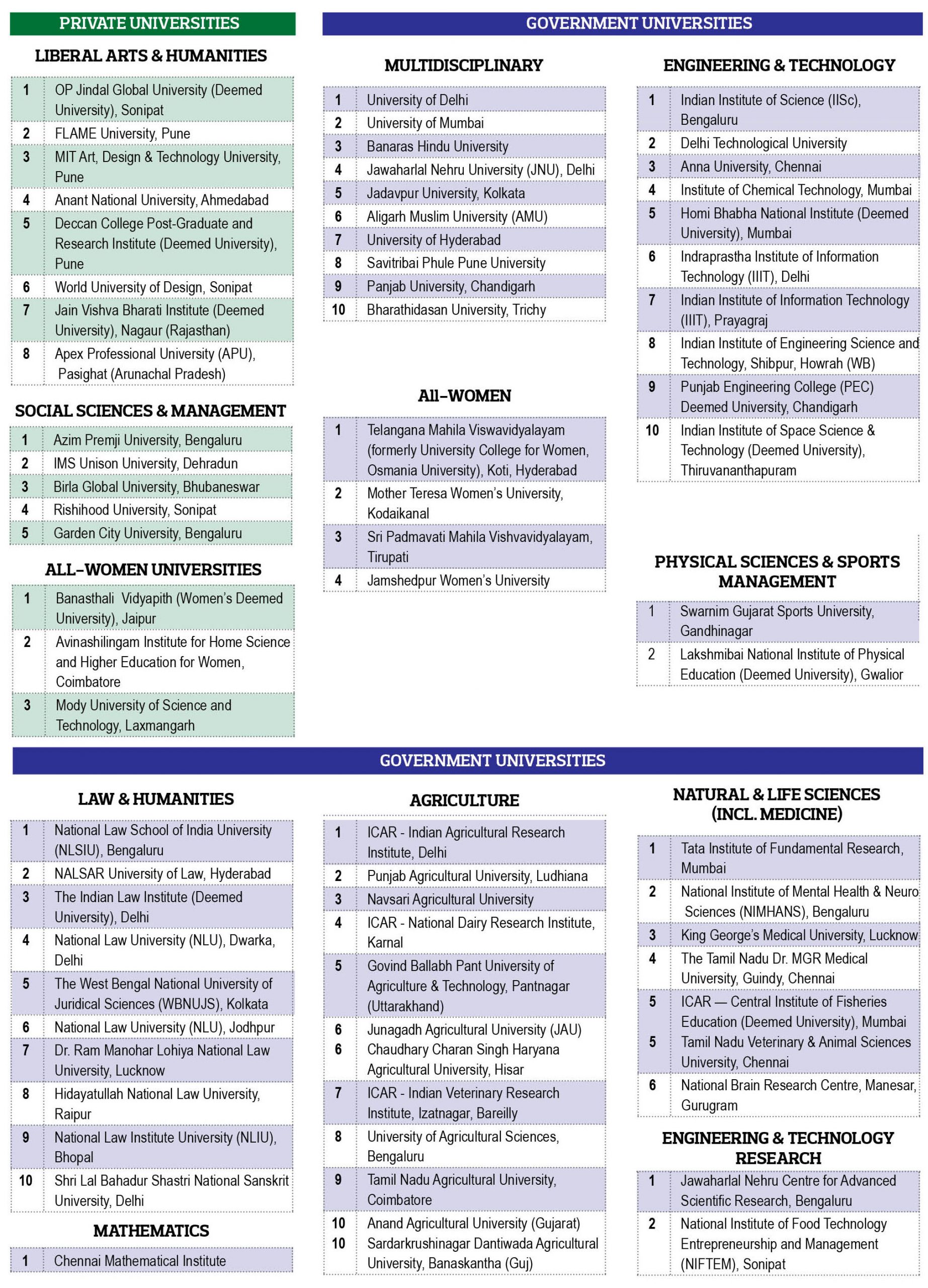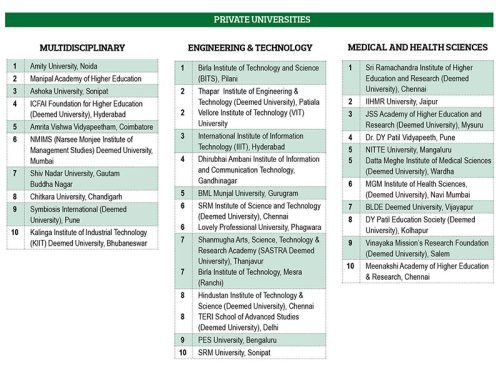EWIHER Top 300 Universities 2024-25
To compile the league table of India’s most admired public and private universities, 2,100 respondents, comprising faculty and students in higher education institutions and industry leaders in 22 states countrywide were interviewed, writes Dilip Thakore and Summiya Yasmeen


Although learned professors and academics in their ivory towers seem oblivious and hold themselves blameless, there’s much that’s wrong with post-independence India’s socialist-template higher education system.
The poor condition of the Indian economy — GDP $4 trillion (cf. USA’s $23 trillion and China’s $17 trillion); 40 million ‘educated’ unemployed; low factory and farm productivity, rock-bottom per capita income of $2,064 (cf. USA’s $76,000 and China’s $12,720) — is intimately connected with the country’s moribund higher education system.
News of any earth-shattering or game-changing invention (the internet, smartphone, electric car, green energy etc) emerging from the shady bowers of Indian academia is rare if not non-existent. Yet taxpayers make heavy annual contributions to sustain India’s sputtering public higher education institutions. In the Union budget 2024-25, an allocation of Rs.47,619 crore has been made for public higher education.
The poor condition of India’s universities is reflected in the annual global ranking league tables of the highly reputed London-based academia ranking agencies Quacquarelli Symonds (QS) and Times Higher Education (THE). In the QS World Rankings 2024 which evaluates 1,559 universities across 104 countries, only two of India’s 1,168 universities — IIT-Bombay at #149 and IIT-Delhi #197 — are ranked among the global Top 200. The much trumpeted Indian Institute of Science, Bangalore (IISc, estb.1908) is ranked #225.
In the THE World University Rankings (WUR) 2024 which assessed 1,906 universities in 108 countries, Indian universities have fared worse. India’s top-ranked university is the Indian Institute of Science, Bangalore, ranked in the 201-250 band, followed by Anna University, Chennai (501-600) and IIT-Guwahati (601-800). None of India’s pioneer metropolitan universities in Calcutta, Bombay and Madras established in 1857 are ranked among the global Top 200 by either agency.
It’s noteworthy that all the above are public — established by government — universities. Private universities haven’t fared better. BITS-Pilani (estb.1964), routinely ranked India’s #1 private engineering university by EducationWorld, is ranked in the 801-1000 band by THE.
Perhaps the new crop of private universities established in the new millennium are too young to merit respectable global rankings. The new genre O.P. Jindal Global University, Sonipat (JGU, estb.2009) “made history” when it was ranked among the global 750 by QS in 2022 and deductively, India’s #1 private university. But it is ranked in the 951-1000 band in QS World University Rankings 2024.
The poor rankings of India’s most admired universities in respected international academic league tables is made more painful by the high rankings of Asia’s best universities, and mainland China in particular.
Five Chinese universities (Tsinghua, Peking, Fudan, Shanghai Jiao Tong and Zhejiang) are ranked among the QS Top 100 and another three within the Top 200. Moreover, several other Asian universities are ranked well above IIT-Bombay, top-ranked by QS (#149) and IISc (201-250) by THE. Among them: NUS, Singapore at #8 by QS and #19 by THE, KAIST, South Korea at #56 by QS and even University of Malaya at #65 by QS.
When asked to explain this phenomenon, the response of Indian academics is usual Indian exceptionalism. Foreign ranking agencies accord too much importance to research and not enough to teaching; too much weightage to number of foreign faculty and students; no weightage is accorded to inclusivity (reservations) and affordability. But over the years, these excuses for the status quo and resistance to reform, have worn thin.
It’s time to acknowledge that low rates of economic growth, poor farm, factory and administrative productivity, are all outcomes of a substandard K-12 education system, low grade higher education institutions, especially universities. The plain truth is that India’s 1,168 universities, several of which were established over a century ago, haven’t produced any meaningful innovations and inventions for 75 years. Smug academics — big fish in small ponds — seem unaware that the great majority of the estimated 10 million graduates they nonchalantly certify annually, are far from job-ready and require extensive and expensive post-induction training before they become minimally productive.
According to the State of Working India 2023 report of the Bengaluru-based Azim Premji University, 42 percent of India’s under-25 graduates were unemployed in 2021-22. And this is not because there are no vacancies in industry and business within the economy which is growing at a satisfactory 6-7 percent per year. Quite the contrary. Most captains of India Inc lament the unavailability of sufficiently well-qualified and skilled youth for managerial and shop-floor jobs.
Likewise after analysing the job-readiness of 440,000 young graduates in 2,500 campuses across India, in its India Graduate Skills Index, Mercer/Mettl, a New York-based firm with several offices in India that bills itself as the “world’s fastest, largest online assessment and certification company”, reports that only 53 percent of Indian graduates are employable for top non-technical jobs and 44 percent for top technical jobs. Conversely, this implies that 47 percent and 56 percent are not sufficiently qualified which adds up to an alarming number of certified youth emerging from academia and searching for jobs in industry and commerce.
Well aware of the poor quality of 10 million graduates streaming out of India’s higher education institutions every year and its implications for growth and development of the economy, since 2013, your editors have been publishing the EducationWorld India Higher Education Rankings to prompt India’s also-ran higher education institutions (HEIs) to upgrade across a range of carefully selected parameters of higher education excellence. Particularly since the HEI evaluation methodology of NAAC (National Assessment and Accreditation Council), a subsidiary of the University Grants Commission (UGC), doesn’t — and never did — inspire much confidence. Even though it was established in 1994, thus far only 9,062 colleges and universities have volunteered for NAAC accreditation.
Last summer, Bhushan Patwardhan, Chairman of NAAC, resigned in dramatic circumstances citing “malpractices,” “manipulation” and “questionable grades” awarded by NAAC to favoured HEIs. This, as we remarked on this page last year, was hardly novel news for us because over the years, NAAC had besmirched its reputation by awarding five-star rating to numerous colleges and universities that didn’t deserve even three.
With NAAC having proved a lame duck, in 2015 the Union education ministry — which has adopted a policy of calculated indifference towards EducationWorld — introduced its NIRF (National Institutional Ranking Framework). Although NIRF rankings are often cited by several universities as proof of academic excellence, some of its rankings are ex facie absurd and have adversely affected the credibility of this new framework. For instance, in the latest NIRF 2023 league table of India’s Top 100 engineering universities, BITS Pilani which has several campuses in India and one abroad, is ranked #25, below several obscure provincial universities.
That’s perhaps why several excellent private engineering HEIs which routinely rank high in the annual EWIHER — Vellore Institute of Technology, IIIT-Hyderabad, Dhirubhai Ambani Institute of Information & Communication Technology, Gandhinagar — don’t submit data (participation is voluntary) to be ranked in NIRF.
Admittedly, several media publications including India Today also publish annual college and university rankings. But these are essentially politics-oriented publications lacking the specialist education know-how and focus of EducationWorld. Therefore, it is submitted that the annual EW league tables of colleges and universities — defined by careful categorisation to eliminate apples with oranges type comparisons — are the most reliable and accurate.
Against this backdrop, last month (April) we presented Part-I of EWIHER 2024-25 rating and ranking India’s Top 500 Arts, Science, Commerce (ASC) and private engineering colleges. In this issue, we rate and rank India’s most admired public and private Multidisciplinary, Engineering & Technology, Liberal Arts and Humanities, Agriculture, Research, Medical & Health Sciences, Social Sciences, Mathematics, Physical Sciences & Sports and all-women’s universities. To this long list, also add private B-schools and the Top 10 most popular undergrad courses and institutions that provide them.
Together with our Arts, Science and Commerce and private engineering college league tables published last month, this is the widest range of HEIs evaluated and ranked by any media publication.
Moreover in our continuous search for excellence, in a departure from past practice, this year we have replaced our field research partner the Gurgaon-based Centre for Forecasting & Research Pvt. Ltd (C fore) with the Bengaluru-based AZ Research Partners Pvt. Ltd to compile the much anticipated EWIHER 2024-25. In our considered opinion, AZ Research Partners Pvt. Ltd (estb.2002) has better credentials for conducting quantitative and qualitative market research. Its clientele includes blue-chip companies such as Tata Hitachi, IndusInd Bank, Mars Chocolates, WPP Group, Pearson Group and significantly Ashoka, Mahindra and BML Munjal universities, among others.
“For this survey, we constituted a sample base of 2,100 respondents, comprising 1,100 students, 800 faculty in higher education institutions and 100 industry leaders in 22 states countrywide. In face-to-face, telephonic and online interviews they were requested to rate public and private multi-disciplinary universities and other HEIs they were familiar with on ten parameters of higher education excellence devised by EducationWorld viz, competence of faculty, faculty welfare and development, curriculum & pedagogy, industry interface, placement, infrastructure and facilities and leadership/governance, value for money and range and diversity of programmes. The interviews with target respondents were conducted over a period of three months by our market research personnel. Thanks to EducationWorld’s excellent reputation built over almost 25 years, we didn’t experience any problems of access and response,” says Shubra Misra, promoter-director of AZ Research. An alumna of IIM-Lucknow, Misra is a highly experienced market research and industry professional having served with the pioneer ORG-MARG (now A.C. Nielsen), Blackstone MR (now Synovate) and Tata Global Beverages for an aggregate 25 years before co-promoting AZ Partners two decades ago.
In the pages following, we present league tables rating the country’s most admired HEIs enumerated above. They provide a rich mine of information for students aspiring for higher education, and also a roadmap for HEI leaders and faculty to bridge the wide gap that separates India’s most admired HEIs from their counterparts abroad. This quality gap has to be bridged if aspirations expressed to transform India into a $30 trillion economy and Viksit Bharat (‘developed India’) are to progress beyond mere wishful thinking.

















Add comment